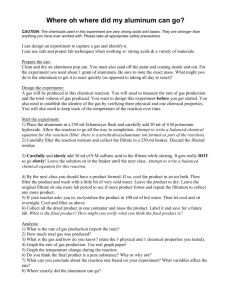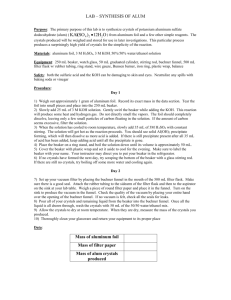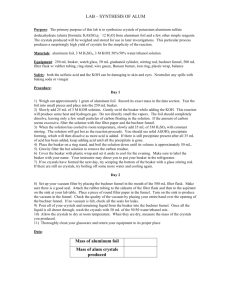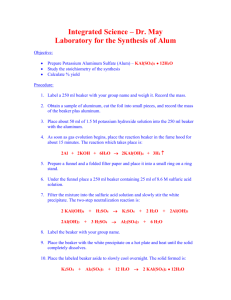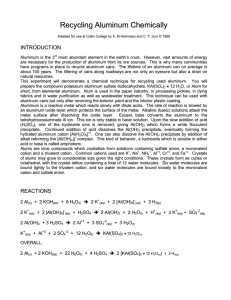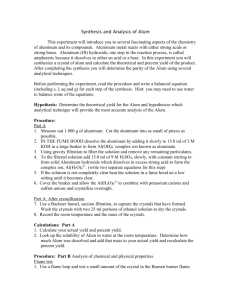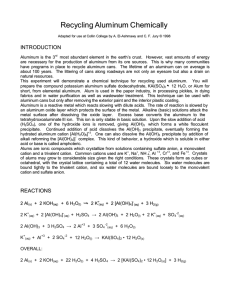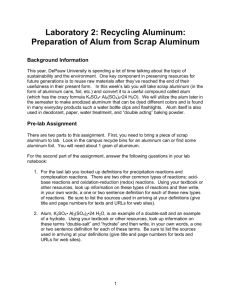Experiment 2 Recycling Aluminum
advertisement
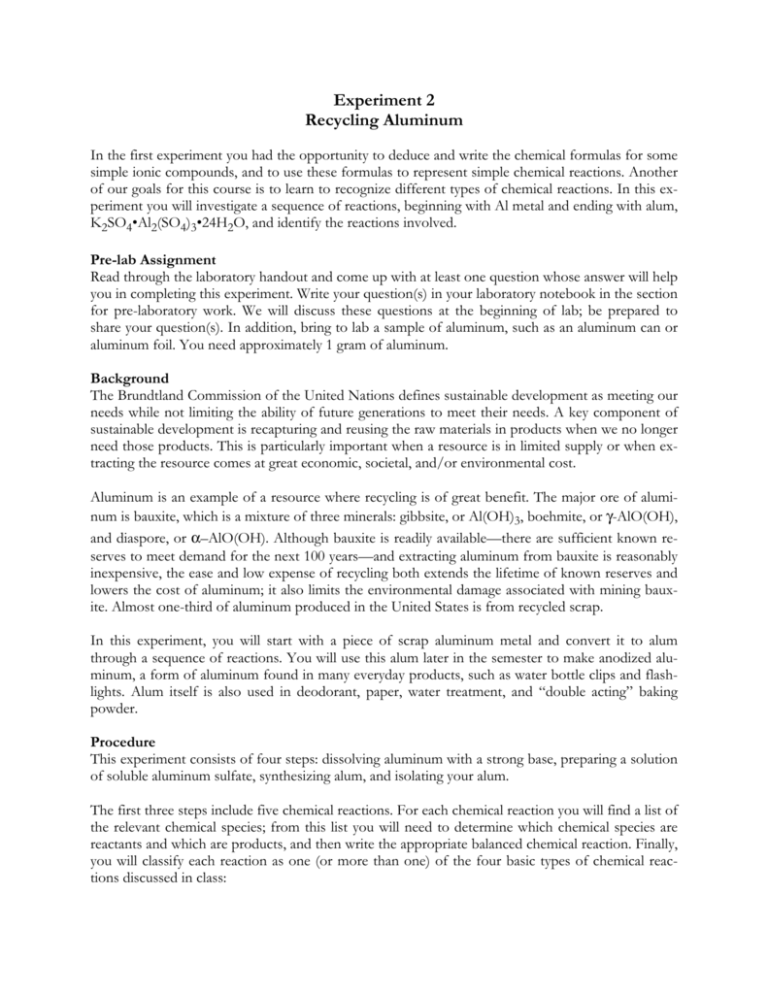
Experiment 2 Recycling Aluminum In the first experiment you had the opportunity to deduce and write the chemical formulas for some simple ionic compounds, and to use these formulas to represent simple chemical reactions. Another of our goals for this course is to learn to recognize different types of chemical reactions. In this experiment you will investigate a sequence of reactions, beginning with Al metal and ending with alum, K2SO4•Al2(SO4)3•24H2O, and identify the reactions involved. Pre-lab Assignment Read through the laboratory handout and come up with at least one question whose answer will help you in completing this experiment. Write your question(s) in your laboratory notebook in the section for pre-laboratory work. We will discuss these questions at the beginning of lab; be prepared to share your question(s). In addition, bring to lab a sample of aluminum, such as an aluminum can or aluminum foil. You need approximately 1 gram of aluminum. Background The Brundtland Commission of the United Nations defines sustainable development as meeting our needs while not limiting the ability of future generations to meet their needs. A key component of sustainable development is recapturing and reusing the raw materials in products when we no longer need those products. This is particularly important when a resource is in limited supply or when extracting the resource comes at great economic, societal, and/or environmental cost. Aluminum is an example of a resource where recycling is of great benefit. The major ore of aluminum is bauxite, which is a mixture of three minerals: gibbsite, or Al(OH)3, boehmite, or γ-AlO(OH), and diaspore, or α–AlO(OH). Although bauxite is readily available—there are sufficient known reserves to meet demand for the next 100 years—and extracting aluminum from bauxite is reasonably inexpensive, the ease and low expense of recycling both extends the lifetime of known reserves and lowers the cost of aluminum; it also limits the environmental damage associated with mining bauxite. Almost one-third of aluminum produced in the United States is from recycled scrap. In this experiment, you will start with a piece of scrap aluminum metal and convert it to alum through a sequence of reactions. You will use this alum later in the semester to make anodized aluminum, a form of aluminum found in many everyday products, such as water bottle clips and flashlights. Alum itself is also used in deodorant, paper, water treatment, and “double acting” baking powder. Procedure This experiment consists of four steps: dissolving aluminum with a strong base, preparing a solution of soluble aluminum sulfate, synthesizing alum, and isolating your alum. The first three steps include five chemical reactions. For each chemical reaction you will find a list of the relevant chemical species; from this list you will need to determine which chemical species are reactants and which are products, and then write the appropriate balanced chemical reaction. Finally, you will classify each reaction as one (or more than one) of the four basic types of chemical reactions discussed in class: 1. 2. 3. 4. an oxidation–reduction reaction, in which electrons are transferred between species a precipitation reaction, in which a solid forms from an exchange of ions between species an acid–base reaction, in which a proton is transferred between species a complexation reaction, in which one species donates an electron pair to another species As you complete each reaction, describe carefully in your lab notebook everything you observe, including the color of solutions and precipitates, whether a gas is produced, and any other noteworthy information. These observations will help you in identifying reactants and products, and in determining the types of reactions taking place. Note: water (H2O) is present in all reaction mixtures, so you may include it as a reactant or product as needed to balance a reaction. Step 1. Dissolving Aluminum with a Strong Base This step consists of a single reaction, for which the relevant chemical species are H2, Al(OH)4–, Al, KOH, and K+. Caution: much of this step must be completed in a hood. Once you begin working in the hood, do not remove your beaker until the directions specifically note that you can do so. Weigh an approximately 1 gram piece of scrap aluminum. If your sample is too large (>1.1 g), then trim as needed; if it is too small (<0.9 g), then add additional material. Cut your sample of Al into small pieces, reweigh to determine the sample’s exact mass, and then place it in a 250 mL beaker. Working in a hood, add 15 mL of 6 M potassium hydroxide and cover the beaker with a watch glass. Place the beaker on a hot plate and heat gradually using a moderate setting (do not turn the heat up all the way!). Watch the solution carefully and as soon as it starts to react visibly, add 35 mL of deionized H2O. Note the approximate volume of solution in your beaker after this addition, and use your water wash bottle to maintain this height while it heats. Do not add excess water as this dilutes the base and slows the reaction. Continue heating until the aluminum metal is no longer visible, and the reaction ceases. When you think the reaction is complete, carefully remove the beaker from the hot plate—use a heat resistant glove or paper towels to protect your hands—place it on a white sheet of paper, and gently swirl the solution; if foam appears on the surface of the liquid, then the reaction is not yet complete and needs additional heating. You may observe fine black particles suspended in the solution; this is a contaminant from the coating on your sample of aluminum and is not part of the reaction—this impurity, and other undissolved solids are removed by filtration. You may now return to your lab bench. Using the illustration below as a guideline, prepare a piece of filter paper by folding it into quarters and placing it in your short stem funnel. Wet the paper with a small amount of distilled water to ensure a good seal at the top. Place the funnel over a 250 mL beaker, which will serve as a vessel for collecting your filtrate. While the liquid is still hot, pour it into the funnel and collect the filtrate. Rinse the reaction vessel with two portions of approximately 3 mL of deionized water each, and pass these through the filter as well. Discard the filter paper and save the filtrate for the next step. Step 2. Preparing a Solution of Soluble Aluminum Sulfate This step consists of three separate reactions, the first two of which happen so quickly that it is hard to distinguish them! For the first of the reactions, the relevant chemical species are H2SO4, K2SO4, and KOH. For the second reaction, the relevant chemical species are Al(OH)3, H2SO4, Al(OH)4–, and SO42–. Finally, for the third reaction, the relevant chemical species are Al(OH)3, Al2(SO4)3, and H2SO4. Place 35 mL of 6 M sulfuric acid in a small flask. Slowly add the sulfuric acid to the filtrate from step one until you observe the formation of an insoluble precipitate. Place the beaker on a hot plate and heat the solution while adding the rest of the sulfuric acid. Allow the solution to warm until it just starts to steam. If your solid fails to completely dissolve, add a little more acid (2 mL) and heat a bit longer. Repeat this process until the solid completely dissolves. Be sure to record the total amount of acid added to your flask. Save this solution for the next step. Step 3. Synthesizing Alum This step consists of a single reaction, for which the relevant chemical species are K2SO4, K2SO4•Al2(SO4)3•24H2O, and Al2(SO4)3. Using ice and water, prepare an ice bath in a container large enough to hold the beaker containing the reaction mixture from the previous step. Place your beaker in the ice bath and allow the solution to cool. Crystals of alum will appear on the bottom of your beaker as a very fine, sandy, white layer. If crystals do not form after approximately 10 minutes, scratch the bottom of the beaker with a glass stirring rod or add a seed crystal of alum from someone else’s product to aid the crystal formation. (Note: While you are cooling your solution, place 10 mL of methanol in a small flask and begin cooling it in the ice bath for use in the next step.) Step 4. Isolating Your Alum To isolate your alum, set up on the vacuum filtration apparatus illustrated below. Weigh your filter paper before placing it in the Büchner funnel. Check with your instructor before proceeding to make sure you correctly set up the vacuum filtration apparatus. Transfer your alum crystals by swirling the liquid and crystals in your beaker and pouring the resulting suspension into the Büchner funnel while applying suction with a vacuum aspirator. Use a spatula to transfer as much as possible of your remaining crystals. To complete the transfer of your crystals to the filter, you will use some of your filtrate. Break the vacuum by removing the hose from the side arm of your flask. Remove the Büchner funnel and pour the filtrate into a small clean beaker. Replace the Büchner funnel, reattach the hose, and reapply the vacuum. Using small portions of your filtrate, transfer the remaining alum crystals from the reaction vessel onto the filter. Finally, wash the crystals in the Büchner funnel using several small 2 mL portions of your filtrate. Caution: do not use deionized water to transfer or wash your crystals as it will dissolve your alum. Your alum is still a bit wet at this point. To remove excess water from your crystals, use a disposable pipet to add slowly the 10 mL of cold methanol prepared during the previous step. Note: when the methanol hits the filtrate in the filtration flask, it will form crystals of excess K2SO4, not alum; do not attempt to collect these crystals. Remove the top part of your Büchner funnel—you can pop it off from the remainder of the funnel—and allow the alum to dry in your drawer until the next lab period. Transfer the filter paper and your crystals to a watchglass and determine the mass of your alum crystals (be sure to correct for the mass of your filter paper). Transfer your crystals to a glass vial and label it with your name, the formula, and the mass. Waste Disposal Dispose of all waste into the container provided in the hood. Lab Report Complete the worksheet provided by your instructor. References This laboratory is adapted from a version developed by Deberah Simon of Whitman College.
